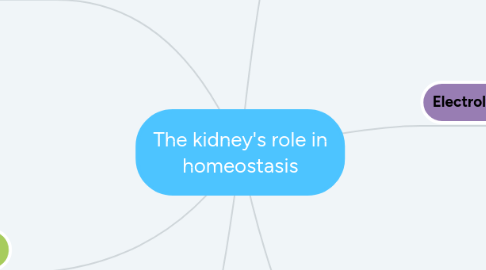
1. Waste excretion in urine
1.1. Excess ions- sodium, potassium, calcium, magnesium, chloride, bicarbonate, phosphate and ammonium.
1.2. Metabolic wastes- urea, creatinine, uric acid, nitrogenous waste.
1.3. Drug metabolites-most pharmacological agents are detoxified in liver and then excreted through the kidney.
1.4. Metabolites of hormone-for example human chorionic gonadotrophin in the urine in early pregnancies.
2. pH balance
2.1. pH scale is a logarithmic scale (range 1-14) that measures the concentration of free hydrogen ions in a fluid. The scale is reciprocal, when pH is low, hydrogen ions is high. Normal pH is between 7.35-7.45.
2.1.1. Kidney controls the acid base balance by controlling the bicarbonate ions concentration in the body.
2.1.1.1. When plasma bicarbonate concentration is normal (25mmol/l) then all of the filtered bicarbonate is reabsorbed in the proximal tubule and distal tubule.
2.1.1.2. When the plasma bicarbonate concentration is higher than normal, then excess bicarbonate is lost in the urine. Or, undergoes bicarbonate ‘trapping’ where bicarbonate ion is reserved in the blood and excretes excess hydrogen ions.
2.2. The rise in hydrogen ion concentration (acidosis) is corrected by kidneys by secreting the excess hydrogen ion into the urine and in the process generating further bicarbonate for reabsorption into the plasma. Fall in hydrogen ion concentration (alkalosis) in the body fluids is corrected by kidney by reducing the amount of hydrogen ion secretion in the urine.
3. Erythropoietin production
3.1. This hormone is produced by erythropoietin-producing cells of the kidney to maintain normal red cell count and prevention of anemia.
3.1.1. Erythropoietin production is stimulated by hypoxia and stopped when hypoxia is corrected, thus, its production is controlled by the negative-feedback principle.
4. Fluid volume balance
4.1. ADH- is secreted by the posterior pituitary gland and ADH receptors are found in collecting ducts of kidney tubules.
4.1.1. When there is rise in plasma osmolality, water is reabsorbed into the blood, diluting the plasma and reducing osmolality to normal.
4.1.2. A fall in plasma osmolality leads to decrease in ADH secretion by negative feedback. ADH receptors are found in collecting ducts of kidney tubules.
4.2. Aldosterone- is a steroid hormone secreted from the adrenal cortex of the kidney and effects the distal tubule of the nephron. Secretion of aldosterone is regulated by peptide, angiotensin II.
4.2.1. When more aldosterone is secreted, the more sodium is reabsorbed and therefore water is reabsorbed.
4.3. Atrial natriuretic peptide (ANP)- is released from cardiac atrial cells in response to stretch in atrium from fluid overload.
4.3.1. ANP inhibits aldosterone secretion by adrenal cortex, reduce renin release by kidney and reduction of ADH from the posterior pituitary to reduce the fluid volume by excreting sodium and water.
5. Electrolytes balance
5.1. Potassium- Aldosterone is the only hormone involved in the control of potassium content in the body.
5.1.1. Small increase of extracellular potassium directly stimulates adrenal cortex to produce aldosterone which affects the distal tubule of the nephron to secrete potassium into the urine.
5.1.2. When the aldosterone level falls, the reverse occurs and less potassium is secreted and is controlled by negative feedback system.
5.2. Calcium- is important in the extracellular fluid in controlling nerve and muscle conduction.
5.2.1. Calcium reabsorption occurs depending on the level of circulating parathyroid hormone (PTH).
5.3. Phosphate-is important in buffer systems to maintain the plasma pH and exists in equilibrium with calcium.
5.3.1. When plasma phosphate level is low, the filtered phosphate is reabsorbed in the early proximal tubule and if it is high, it is excreted in the urine.
5.4. Magnesium-also an important intracellular cation involved in energy storage and production.
5.4.1. Similar to calcium, increase in PTH, increase tubular reabsorption of magnesium.
6. Blood pressure control
6.1. Macular densa in the wall of distal tubule make contact with cells in the endothelium of the arterioles which release a hormone called renin, this is called juxtaglomerular apparatus which maintains a constant blood flow through the glomerulus through tubule feedback mechanism.
6.1.1. Renin acts via the renin angiotensin system to produce both local vasoconstriction of the efferent arteriole increasing GFR ad also peripheral vasoconstriction to increase arterial blood pressure.
6.2. For example: when there is dehydration, sodium deficiency, or haemorrhage, there will be decrease in blood volume and blood pressure.
6.2.1. This will stimulate kidney to produce renin which produce angiotensin I which is converted to angiotensin II.
6.2.1.1. Release of angiotensin II stimulates adrenal cortex to produce aldosterone which reabsorbed more sodium and water and eliminates potassium which increase blood volume and blood pressure.

